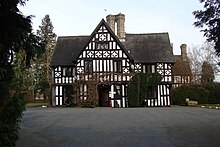
Montgomeryshire, also known as Maldwyn, is one of thirteen historic counties and a former administrative county of Wales. It is named after its county town, Montgomery, which in turn is named after one of William the Conqueror's main counsellors, Roger de Montgomerie, who was the 1st Earl of Shrewsbury.

Newtown is a town in Powys, Wales. It lies on the River Severn in the community of Newtown and Llanllwchaiarn, within the historic boundaries of Montgomeryshire. It was designated a new town in 1967 and saw population growth as firms settled, changing its market town character. Its 2001 population of 10,780 rose to 11,357 at the 2011 census.

Llanidloes is a town and community on the A470 and B4518 roads in Powys, within the historic county boundaries of Montgomeryshire, Wales. The population in 2011 was 2,929, of whom 15% could speak Welsh. It is the third largest settlement in Montgomeryshire, after Newtown and Welshpool.
Berriew is a village and community in Montgomeryshire, Powys, Wales. It is on the Montgomeryshire Canal and the Afon Rhiw, near the confluence with the River Severn at grid reference SJ185005, 79 miles (128 km) from Cardiff and 151 miles (243 km) from London. The village itself had a population of 283. and the community also includes Garthmyl Hall and Refail.

Pontrobert is an ecclesiastical parish that was formed in September 1854. It comprises the townships of Teirtref and part of Nantymeichiaid in the parish Meifod, a portion of Cynhinfa which was in the parish of Llangynyw and portions of the townships of Fachwel, Llaethbwlch and Cadwnfa which were in the parish of Llanfihangel. The total area of this parish is 5,000 acres. As a result of this arrangement, Pont Robert is now divided between the present day Community Councils of Meifod, Llangyniew and Mawddwy. Pontrobert was within the historic county of Montgomeryshire, now forming part of Powys. The name Pontrobert is derived from Robert ap Oliver of Cyhinfa, who built the original bridge over the River Vyrnwy around 1700. An alternative Welsh name for Pontrobert is Pont y ddolfeiniog.
Kerry is a village and geographically large community in Montgomeryshire, Powys, Wales.
The office of High Sheriff of Montgomeryshire was established in 1541 since when a High Sheriff was appointed annually until 1974 when the office was transformed into that of High Sheriff of Powys as part of the creation of Powys from the amalgamation of Montgomeryshire, Radnorshire and Brecknockshire. Between the Edwardian Conquest of Wales in 1282 and the establishment of the High Sheriff of Montgomeryshire in 1541 the sheriff's duties were mainly the responsibility of the coroner and the Custos Rotulorum of Montgomeryshire. The Office of High Sheriff remained first in precedence in the County until the reign of Edward VII when an Order in Council in 1908 gave the Lord Lieutenant of Montgomeryshire the prime Office under the Crown as the Sovereign's personal representative.
Trewern is a small village, community and electoral ward in Montgomeryshire, Powys, Wales. The community includes the villages of Buttington and Middletown, situated 4.5 miles (7 km) northeast of Welshpool, 14.5 miles (23.5 km) west of Shrewsbury and 1 mile (1.6 km) west of the Wales-England border.

Arwystli was a cantref in mid Wales in the Middle Ages, located in the headland of the River Severn. It was chiefly associated with the Kingdom of Powys, but was heavily disputed between Powys, Gwynedd, and the Norman Marcher Lords for hundreds of years, and was the scene of many skirmishes between those groups. Like many other cantrefs and subdivisions, it was divided up by the Laws in Wales Acts in the 16th century.
Great Cefnyberen is a Grade II timber framed house in the township of Cefnyberen in the historic parish of Kerry, Montgomeryshire. A date stone on the gable of the projecting wing, indicates that the south frontage of the house was refaced in stone in 1743.

Tŷ Mawr is a Grade I-listed timber framed house in the township of Trefnant in the historic parish of Castle Caereinion, Montgomeryshire, Wales.
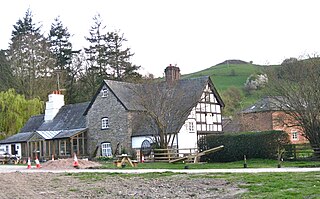
Cilthriew is a Grade II listed house and former farm in Kerry, Powys, in the historic county of Montgomeryshire, now Powys. Cilthriew was used by the Papworth Trust which provided a range of high quality services for disabled and disadvantaged people. Cilthriew provided free short breaks for disabled people and their families in a farm surrounding.
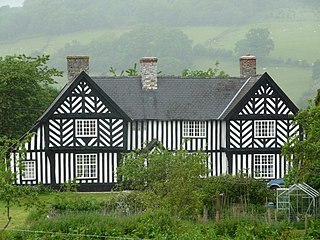
Penarth is a timber-framed house set back from the A483 road near to Newtown, Wales, close to the banks of the river Severn. It is within the parish of Llanllwchaiarn, within the historic county of Montgomeryshire, which now forms part of Powys. It is amongst the best examples of the ‘‘Severn Valley’’ timber-framed houses. The Penarth vinyard stands within the grounds of the house.
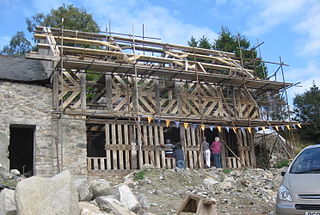
Glas Hirfryn is a farm in Cwmdu, at east side of the road through the valley of the Lleiriog on the southern side of the Berwyn Mountains. It is in the community of Llansilin, which was formerly in Denbighshire, but since 1996 has been in the Montgomeryshire part of Powys. The timber-framed farmhouse, which stands within a group of farm buildings was abandoned in the mid-20th century, at which time it was listed as Grade II. The house has now been dated by dendrochronology to about 1559 AD or shortly afterwards.
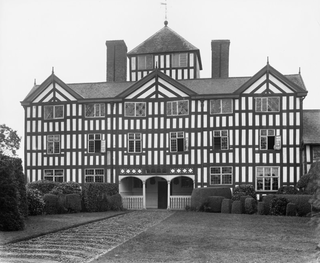
Lymore, or Lymore House or Lodge was demolished in 1931. It stood in Lymore Park, one mile ESE of Montgomery, Powys, Wales. The house was a large half-timbered house built by Edward Herbert, 3rd Baron Herbert of Chirbury, c. 1675, to replace the family residences in Montgomery Castle and Black Hall in Montgomery. The House, which had been uninhabited but maintained for many years, was used for an event in 1921, when one of the floors collapsed with disastrous consequences, resulting in demolition in 1931. The Earls of Powis still own and maintain the park. The park includes the grounds of the Montgomery Cricket Club, which is the oldest cricket pitch in Montgomeryshire. Offa's Dyke forms the eastern boundary of the park.
Trewern Hall or Trewern Farmhouse is a country house in Montgomeryshire, Wales, close to the Shropshire border. It is on a spur in the floodplain of the River Severn, in the Trewern community area of what is now Powys, to the north of the A458 road from Shrewsbury to Welshpool. It is a fine example of a Severn valley half-timbered house. The Grade II* listed hall was occupied by the Lloyd, Francis and Whittaker families. In 1985–86 and 1993–94 it was extensively restored with some remodelling by the architect M. J. Garner for Murray Ll. Chapman.

Plasau Duon or Plasauduon is a timber-framed house, formerly in the parish of Carno, but now within the area of the community council of Caersws in the historic county of Montgomeryshire, and now in Powys, Wales. It is located on a site above the left bank of the Afon Carno, on a farm road leading off the lane from the A.470 to Bwlch-y-garreg. It is a fine example of a ‘’Severn Valley’’ house and has a Grade II* listing. It is likely to have been built in the second half of the 16th. century.

The Royal House in Machynlleth is a 16th-century merchant’s house with extensive interior timber framing, clad in stone on the outside, with two massive chimney stacks. The building has been dated by dendrochronology, or tree-ring dating, giving felling dates for timbers within the house of 1559–1561, and for the rear store-house range of 1576. The building was acquired by the Machynlleth Tabernacle Trust and excavations and survey were undertaken by CPAT before restoration work was started in 2005. The restoration was supported by the Heritage Lottery funding.

Owain Glyndŵr's Parliament House was traditionally the building where Owain Glyndŵr held a parliament after being crowned Prince of Wales in 1404. However the origin of the building is probably later. The existing building may be 15th century in origin, but has been extensively rebuilt, particularly by David Davies of Llandinam, who purchased it in 1906. It was opened on 20 February 1912 to provide a social centre for the town. The present rubble exterior is an interpretation of its 15th century appearance, probably by the architect Frank Shayler, who may also have designed the adjacent Glyndŵr Institute.

Architecture of Wales is an overview of architecture in Wales from the Medieval period to the present day, excluding castles and fortifications, ecclesiastical architecture and industrial architecture. It covers the history of domestic, commercial, and administrative architecture.
